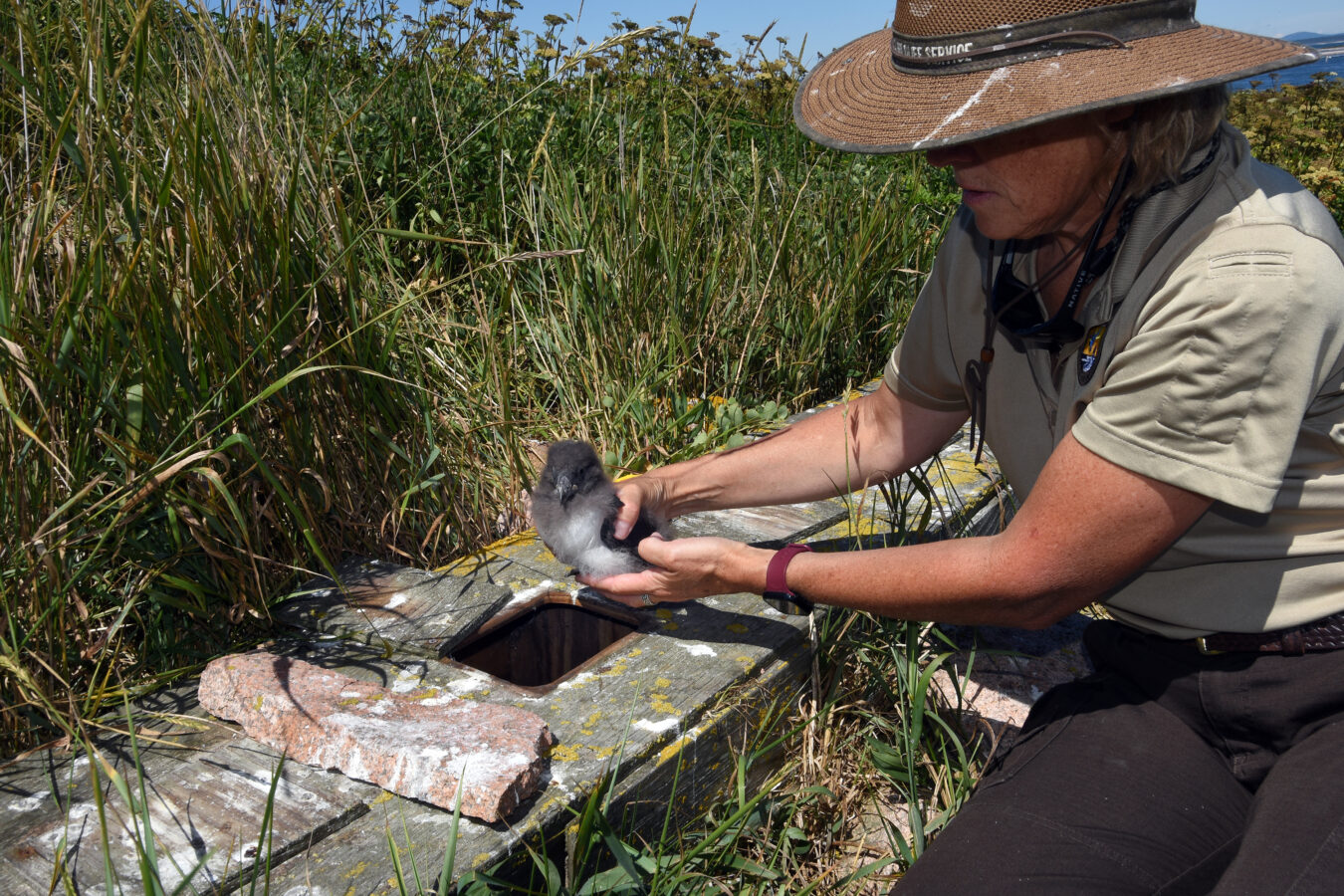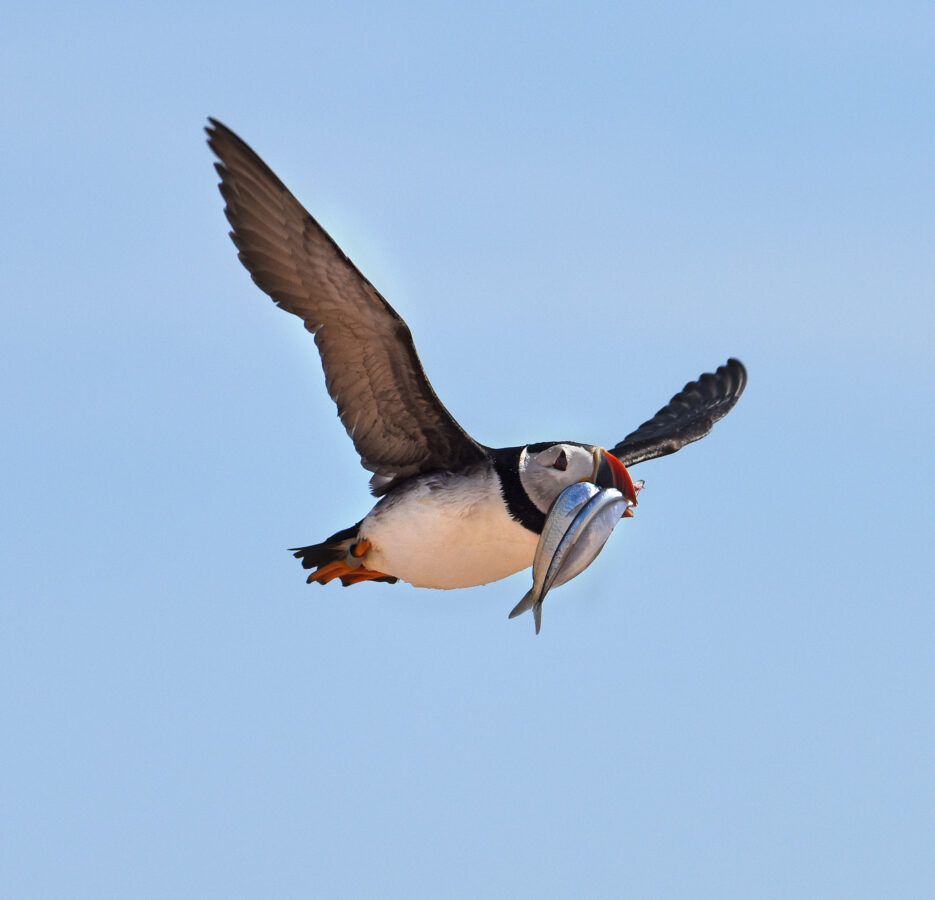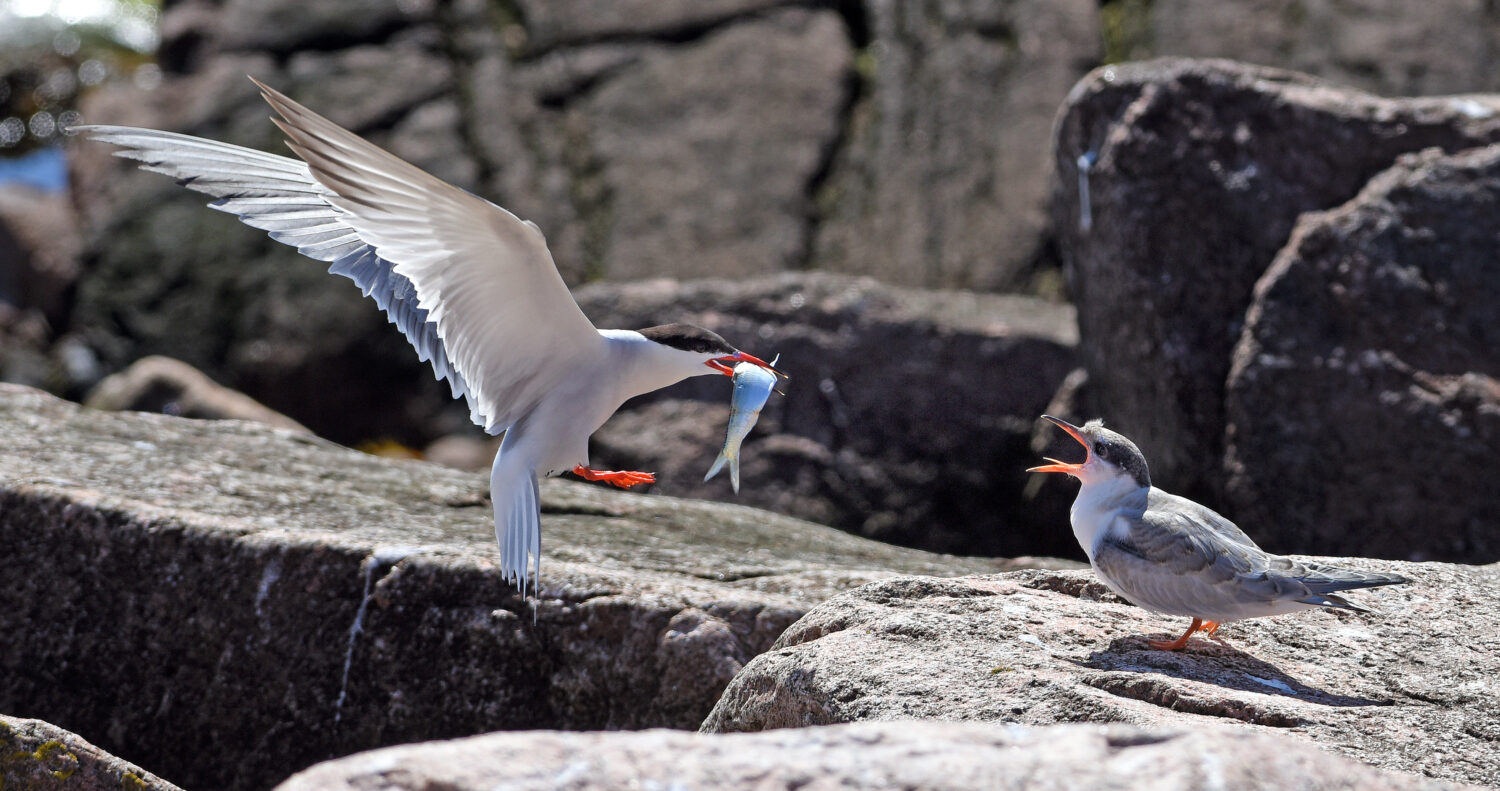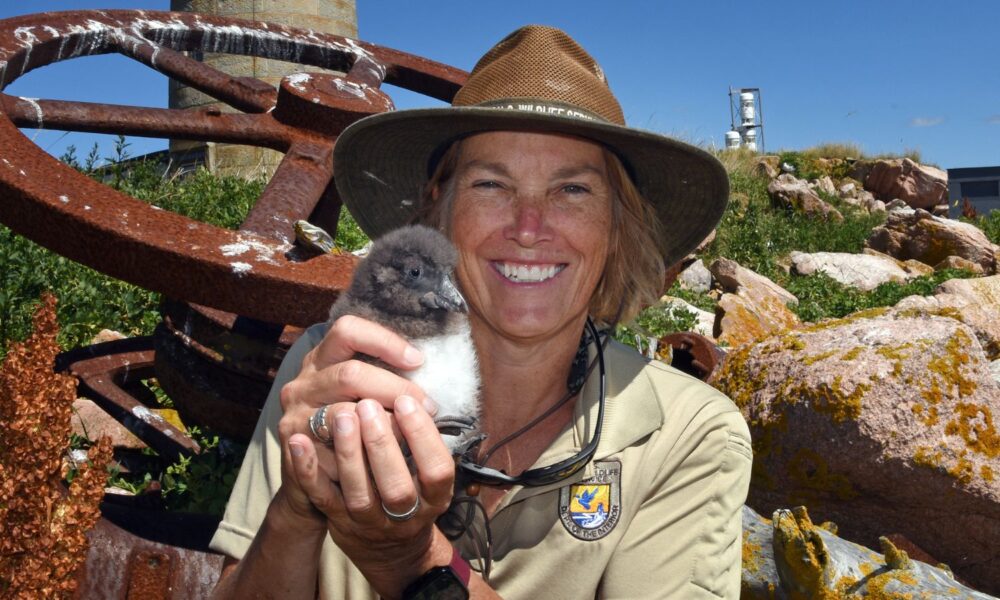The title of supervisory wildlife biologist for the United States Fish and Wildlife Service does little justice to Linda Welch (pictured above). In practice, she is the housing and unusual development secretary for seabirds on Maine’s Petit Manan Island.
This was clear as she led me to nesting areas there for Atlantic puffins. Over the last half century, the bird has been restored from the brink of extinction in Maine, the only state where it breeds. Petit Manan is located about 20 miles east of Acadia National Park and is part of the Maine Coastal Islands National Wildlife Refuge.
The island has a shortage of “housing stock” that other puffin havens in Maine do not. On those other islands, breeding puffins enjoy the privilege of nesting year after year in the same burrow under massive boulders that probably have not shifted for centuries.
Petit Manan is not so blessed. The rocks around its rim are often much smaller. Puffins can still nest under them. But winter storms easily scramble them and obliterate burrow openings. Already an annual headache for a bird that is loyal to its nesting spot, the rearranging of rocks is now a figurative migraine as climate change from the world’s burning of fossil fuels intensifies rain, wind and crashing waves. During the last decade, one set of storms slashed the number of burrows from more than 90 down to 52.
“We had lot of burrows on the east side of the island three years ago,” Welch said. “Now they’re all gone. In the past we’ve always lost a few burrows to storms. But beginning with some storms in 2012, it’s become frustrating. Even this year, which is turning out to be a good year for seabirds, it’s been difficult. In March, we went out to look at the burrows and everything looked perfect. Then a huge storm came in April, and everything got smashed.”
Scheming and tinkering
Given the fragility of puffin burrows and nature’s increasing fury, Welch 55, and a 25-year veteran of the the Maine Coastal Islands refuge, has long schemed of ways to build artificial burrows with every material possible to give puffins an inviting place to nest. She and her colleagues have tried bricks and chimney liners. She has tried flowerpots and corrugated pipe for septic systems. She has tried burying culvert pipe and plastic tote buckets and tunneling pathways through sod for the birds to get up and into her contraptions.
She covers them up with rocks and soil to make them look as natural as possible. Anticipating rising seas and longer reaches of reaches of tides and waves driven by storms, she has been moving artificial burrows higher up the island, so high that some puffins are nesting amid the twisted ruins of dwellings for lightkeepers.
“I go to Home Depot with my calipers and sit on the floor and measure materials to design puffin burrows and tern traps,” Welch said. “Initially, they thought I was a weirdo, but it’s a small Home Depot so the people got to know me and say, ‘She’s OK, she’s just designing tern traps.’ I keep believing in the idea of ‘if we build it, they will come.’ You try to be creative and keep improving the burrows, such as digging deeper in the soil to keep the birds cooler. As we continue to tweak our designs, we get to a more natural experience for the birds.”
Today, a third of burrows on Petit Manan are artificial. Among the most impressive was the most obvious. She walked me to a long wooden box. It was one of fourpuffin “condos,” rows of compartments on top of the soil with burrow openings lined were corrugated pipe dug underneath. They had removable covers for researchers to inspect the health of puffin chicks. Welch opened a couple and both times pulled out plump chicks that were about ready to fledge.

“Initially, I had a philosophical debate about whether to build burrows and intervene on the puffins’ behalf. Puffins want to be here, but the habitat is not great. But there are puffins on so few islands, every island we can attract them to feels important.”
A unique puffin success
Petit Manan is important because it represents a unique and encouraging lesson in puffin restoration. The bird was slaughtered for its meat and eggs by coastal communities in Maine in the late 19th century. By 1902, only a single pair of puffins clung to existence on Matinicus Rock, an island 25 miles out to sea from Rockland, the nearest major town on the mainland.
In the early 1970s, Steve Kress, a young bird instructor at National Audubon’s Hog Island summer camp, ran across a 1949 book that said puffins bred in “considerable numbers” off multiple Maine islands in the 19th century. He set about to recreate that spectacle.
Starting with Eastern Egg Rock, a small, seven-acre island six and a half miles off Pemaquid Point, Kress worked with the Fish and Wildlife Service to control voracious gull populations that would have made restoration impossible. Beginning in 1973, he and colleagues began bringing down hundreds of 10-day-old puffin chicks from Newfoundland. They hand raised them on Eastern Egg Rock until they fledged out to sea.
Puffins stay out to sea for two or three years until breeding instincts kick in. Kress gambled that when the chicks became adults, they would pick Eastern Egg Rock over Newfoundland as home.
He guessed right. They began breeding in 1981 and today there are more than 1,300 pairs of puffins across several islands, mostly across Eastern Egg Rock, Seal Island and Matinicus Rock. What became known as Project Puffin was the world’s first restoration of a seabird to an island where humans had killed it off.

The presence of puffins on Petit Manan was a happy accident. There is no historical record of puffins ever having bred on that island. In the 1960s and early 70s, it was home to 1,500 pairs of common, Arctic and roseate terns, Maine’s largest tern colony. But the Coast Guard’s automation of the island’s lighthouse abruptly ended a human presence that had been incidentally protective of terns by keeping gulls at bay. After automation, herring and great black-backed gulls overran the island. By the late 1970s, terns abandoned their colonies.
In 1984, the Fish and Wildlife Service began to control gulls by removing nests and placing poison sandwiches on nests. Just one week into the program, terns begin returning and created a new colony of nearly 1,000 pairs. The calming of the island for terns was so successful that 13 puffins crashed the party and began to successfully breed chicks in 1987. By 2009, a record 104 pairs of puffins bred on Petit Manan, along with more than 2,500 pairs of terns.
That arrival of puffins was likely because of a phenomenon observed with the success of Project Puffin. The screeching and divebombing of terns, meant to dissuade predators such as gulls from swooping down to gobble chicks, also seemed to act as a protective cover for puffins to come onto the islands to prospect for burrows, hatch eggs and bring fish to their chicks.
“If we give nature the opportunity, birds will take advantage,” Welch said.
Giving birds a chance, 24/7
Trying to give nature the opportunity never stops on Petit Manan. As on many seabird research islands in New England, a team of young conservationists at the beginning of their careers live on them during the height of breeding season—from late May until early August—to monitor the health of the birds and combat any dangers that emerge.
There are prescribed burns and constant weed pulling to keep tern habitat from being choked. Several times even during my three-day stay on the island, the crew would make as much noise as it could to shoo away peregrine falcons—a species also rescued from extinction—from preying on terns and puffins.
Then there are laughing gulls. A colony last year built more than 800 nest in the same area as terns, threatening to crowd out the latter. Laughing gulls also try to harass terns and puffins into dropping the fish they bring onto the island for their chicks. This summer, island supervisor Hallie Daly, 25, a graduate of wildlife conservation at the University of California Davis, led her crew on a mission to destroy gull nests and give the gulls second thoughts about setting up shop on Petit Manan by firing off pyrtechicas and hoisting up dead laughing gulls on poles. “We went from 800 gull nests to four nests,” Daly said. “We hopefully saved 20 to 30 tern nests by doing that. Every nest counts.”
This summer, there was an avian flu scare that likely killed dozens of tern chicks and forced the shooting euthanasia of five great black-backed gulls which displayed the loss of body control associated with the virus. “One bird was just rolling over itself,” said Nick Giordano, 25, a graduate of wildlife science at the State University of New York in Syracuse. “It was really rough to witness. It’s so hard to shoot a beautiful animal. But we couldn’t let the disease spread.”
Fortunately, avian flu did not sweep through New England this breeding season in the way that it tore through gannet, skua and tern colonies in Europe and gannet and murre colonies in Atlantic Canada. This summer was also a relief from the roller coaster of climate change. The puffin islands of Maine, as well as Machias Seal Island, an island of between 5,000 and 6,000 breeding pairs of puffins that is administered by Canadian wildlife researchers, all sit in the Gulf of Maine, the fastest-warming body of ocean on Earth.
The effects of global warming on Petit Manan have been as dramatic as on any island. Besides the aforementioned “redecoration” of rocks from storms, water that is too warm drives the fish puffins and terns catch to feed chicks either too deep to find or so far out that parents are exhausted, and chicks are underfed, triggering starvation.
A decade ago, when summer surface water temperatures reached record highs, Petit Manan’s breeding puffin count was more than halved, from the 104 pairs in 2009 to 47 pairs in 2013. Then last year, when Maine recorded even a higher level of record water warmth, puffin and tern breeding was a disaster. Only 13 percent of common tern chicks fledged, compared to nearly 61 percent in the record puffin nesting year of 2009.
Welcome reprieve
This summer, relatively cooler waters have resulted in a breeding bonanza of 93 puffin burrows with 73 chicks hatching. As the research team took me around to investigate puffin burrows and pulled out healthy chick after healthy chick, the caretakers’ broad smiles told the story. “It symbolizes that we are not yet at the point of no return,” Daly said. “We’ve had so much doom and gloom that nothing can be done and this is proof that it can. One of the adults we’ve recaptured was a bird I banded as a chick in 2019. That is the proof.”
Similarly, Jill Tengeres, 29, who has periodically worked summers on Petit Manan and studied Aleutian terns for her masters degree at Oregon State, talked of a bird she recaptured that she banded as a chick 10 years ago. “You get this warm and fuzzy feeling,” Tengeres said. “I’ve seen some bad years where we were down to 40 puffin burrows and dead tern chicks all around. But they still keep coming back. To see their resolve is amazing.”
Also helping to manage the island this summer were Tasha Gownaris, 35, an assistant professor of environmental studies at Gettysburg College, and two of her students, Kaiulani Sund, a 21-year-old senior, and Jehan Mody, a 21-year-old junior. Gownaris has studied Magellanic penguins, fisheries in Kenyan lakes and the importance of forage fish for commercial fisheries and ecosystems.
For her, to see the varieties of nutritious fish being brought this summer by adult puffins and terns to their chicks was nothing short of thrilling. Last year at the peak of water warmth, puffins often brought only tiny hake or butterfish, a species more traditional of the mid Atlantic, which is too oval for small chicks to eat. Terns often brought insects.

This year, puffins were bringing in beak loads of thick, juicy hake, herring, haddock and sand lance several inches long. Both puffins and terns were even bringing in Atlantic saury, a fish as long and thick as a school ruler. Gownaris said seabird chicks were growing at double the rate of last year. She, Sund, Mody and Giordano all remarked how terns will need that fill of fish for their first winter out to sea. Common terns often head to tropical coasts as far south as Argentina and Peru. Arctic terns that breed in the Gulf of Maine may have 20,000-mile migrations that may take them around South Africa into the Indian Ocean and between the tip of South America and Antarctica before returning to places like Petit Manan. One 35-year-old Arctic tern was estimated to have traveled 2.3 million miles in its lifetime.
Giordano said that the fortitude of the birds is all the more humbling when he reads a band on a tern perching on a rock and realizes that it was hatched 20 years ago, or records the return of a puffin that is nearly 30 years old. Project Puffin has seen one puffin make it to 35 years old. “When you hold that band,” Giordano said, “You wonder what that bird has seen. Sund added, “When you hold a bird that travels like it does and it looks into your eyes and you look into its eyes, I constantly wonder what is going on it its mind.”
Mody added, “These birds fight so hard for themselves, we have to fight for them.”
The team and Welch all hope that the “we” who fight for the birds becomes all of us, as climate change from the burning of fossil fuels threatens all their building of artificial burrows, tending to the weeds and scaring off predators. “Until about 10 years ago, the normal cycle was many good years with a bad year here and there,” Welch said. “Now we’re in a situation of multiple bad years and then a good year that is still not a great year.
“When you’ve been here to see thousands of chicks starving to death in a bad year, it’s hard not to think of the consequences if this is the new normal. Every spring I get incredibly anxious, worrying about how many bad years can they take before this is the year they don’t come back. We don’t have the luxury of waiting to do something on climate change. It’s happening all around us, right now.”
Until that day happens, you can find Linda Welch, the secretary of puffin housing and development, on the floor at Home Depot, trying to build a burrow.

